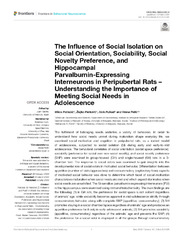Приказ основних података о документу
The Influence of Social Isolation on Social Orientation, Sociability, Social Novelty Preference, and Hippocampal Parvalbumin-Expressing Interneurons in Peripubertal Rats - Understanding the Importance of Meeting Social Needs in Adolescence.
| dc.creator | Potrebić, Milica | |
| dc.creator | Pavković, Željko | |
| dc.creator | Puškaš, Nela | |
| dc.creator | Pešić, Vesna | |
| dc.date.accessioned | 2022-06-08T11:40:57Z | |
| dc.date.available | 2022-06-08T11:40:57Z | |
| dc.date.issued | 2022 | |
| dc.identifier.issn | 1662-5153 | |
| dc.identifier.uri | https://www.frontiersin.org/articles/10.3389/fnbeh.2022.872628/full | |
| dc.identifier.uri | http://www.pubmedcentral.nih.gov/articlerender.fcgi?artid=PMC9113078 | |
| dc.identifier.uri | http://radar.ibiss.bg.ac.rs/handle/123456789/4988 | |
| dc.description.abstract | The fulfillment of belonging needs underlies a variety of behaviors. In order to understand how social needs unmet during maturation shape everyday life, we examined social motivation and cognition in peripubertal rats, as a rodent model of adolescence, subjected to social isolation (SI) during early and early-to-mid adolescence. The behavioral correlates of social orientation (social space preference), sociability (preference for social over non-social novelty), and social novelty preference (SNP) were examined in group-housed (GH) and single-housed (SH) rats in a 3-chamber test. The response to social odors was examined to gain insights into the developmental role of social odors in motivated social behavior. Differentiation between appetitive (number of visits/approaches) and consummatory (exploratory time) aspects of motivated social behavior was done to determine which facet of social motivation characterizes maturation when social needs are met and which aspect dominates when social needs are unsatisfied. The SI-sensitive parvalbumin-expressing interneurons (PVI) in the hippocampus were examined using immunohistochemistry. The main findings are the following: (1) in GH rats, the preference for social space is not evident regardless of animals' age, while sociability becomes apparent in mid-adolescence strictly through consummatory behavior, along with complete SNP (appetitive, consummatory); (2) SH promotes staying in a social chamber/space regardless of animals' age and produces an appetitive preference for it only in early-adolescent animals; (3) SH promotes sociability (appetitive, consummatory) regardless of the animals' age and prevents the SNP; (4) the preference for a social odor is displayed in all the groups through consummatory behavior, while appetitive behavior is evident only in SH rats; (5) the response to social odors does not commensurate directly to the response to conspecifics; (6) SH does not influence PVI in the hippocampus, except in the case of early-adolescence when a transient decrease in the dentate gyrus is observed. These results accentuate the developmental complexity of social motivation and cognition, and the power of SI in adolescence to infringe social maturation at different functional levels, promoting appetitive behavior toward peers overall but harming the interest for social novelty. The findings emphasize the importance of the fulfillment of basic social needs in the navigation through the social world. | |
| dc.publisher | Lausanne: Frontiers Media S.A. | |
| dc.relation | info:eu-repo/grantAgreement/MESTD/inst-2020/200007/RS// | |
| dc.rights | openAccess | |
| dc.rights.uri | https://creativecommons.org/licenses/by/4.0/ | |
| dc.source | Frontiers in Behavioral Neuroscience | |
| dc.subject | 3-chamber test | |
| dc.subject | Adolescence | |
| dc.subject | Animal model | |
| dc.subject | Maturation | |
| dc.subject | Motivation | |
| dc.subject | Social needs | |
| dc.subject | Social odor | |
| dc.title | The Influence of Social Isolation on Social Orientation, Sociability, Social Novelty Preference, and Hippocampal Parvalbumin-Expressing Interneurons in Peripubertal Rats - Understanding the Importance of Meeting Social Needs in Adolescence. | |
| dc.type | article | en |
| dc.rights.license | BY | |
| dc.rights.holder | © 2022 Potrebić, Pavković, Puškaš and Pešić. | |
| dc.citation.volume | 16 | |
| dc.identifier.doi | 10.3389/fnbeh.2022.872628 | |
| dc.identifier.pmid | 35592640 | |
| dc.identifier.wos | 000799192300001 | |
| dc.citation.apa | Potrebić, M., Pavković, Ž., Puškaš, N., & Pešić, V. (2022). The Influence of Social Isolation on Social Orientation, Sociability, Social Novelty Preference, and Hippocampal Parvalbumin-Expressing Interneurons in Peripubertal Rats - Understanding the Importance of Meeting Social Needs in Adolescence. Frontiers in Behavioral Neuroscience, 16, 872628. | |
| dc.citation.vancouver | Potrebić M, Pavković Ž, Puškaš N, Pešić V. The Influence of Social Isolation on Social Orientation, Sociability, Social Novelty Preference, and Hippocampal Parvalbumin-Expressing Interneurons in Peripubertal Rats - Understanding the Importance of Meeting Social Needs in Adolescence. Front Behav Neurosci. 2022;16:872628. | |
| dc.citation.spage | 872628 | |
| dc.type.version | publishedVersion | |
| dc.identifier.fulltext | https://radar.ibiss.bg.ac.rs/bitstream/id/10629/fnbeh-16-872628.pdf | |
| dc.citation.rank | M21 |

